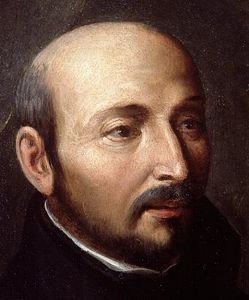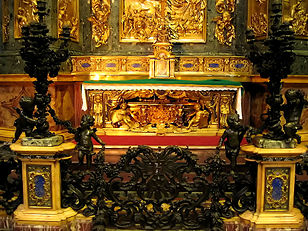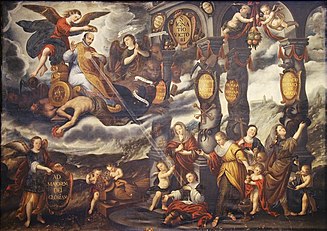
Ignatius of Loyola
Ignatius of Loyola SJ (/ɪɡˈneɪʃəs/ ig-NAY-shəss; Basque: Ignazio Loiolakoa; Spanish: Ignacio de Loyola; Latin: Ignatius de Loyola; born Íñigo López de Oñaz y Loyola; c. 23 October 1491[3] – 31 July 1556), venerated as Saint Ignatius of Loyola, was a Spanish Basque Catholic priest and theologian, who, with six companions, founded the religious order of the Society of Jesus (Jesuits), and became its first Superior General, in Paris in 1541.[4]
Ignatius of Loyola
Iñigo López de Oñaz y Loyola
23 October 1491
Azpeitia, Gipuzkoa, Crown of Castile
31 July 1556 (aged 64)
Rome, Papal States
27 July 1609, Rome, Papal States, by Pope Paul V
12 March 1622, Rome, Papal States, by Pope Gregory XV
31 July
- Sacerdotal vestments
- cassock
- ferraiolo
- biretta
- holding a book with Ad maiorem Dei gloriam inscription
- trampling on a heretic
- IHS Christogram
- crucifix
- rosary
Society of Jesus; soldiers; spiritual retreats; Biscay; Gipuzkoa;[2] Ateneo De Manila University; the Archdiocese of Baltimore, Maryland; the Diocese of Antwerp, Belgium; Belo Horizonte, Brazil; Junín, Buenos Aires, Argentina; Rome, Italy; accidents and injuries.
Ignatius envisioned the purpose of the Society of Jesus to be missionary work and teaching. In addition to the vows of chastity, obedience and poverty of other religious orders in the church, Loyola instituted a fourth vow for Jesuits of obedience to the Pope, to engage in projects ordained by the pontiff.[5] Jesuits were instrumental in leading the Counter-Reformation.[6]
As a former soldier, Ignatius paid particular attention to the spiritual formation of his recruits and recorded his method in the Spiritual Exercises (1548). In time, the method has become known as Ignatian spirituality. He was beatified in 1609 and was canonized as a saint on 12 March 1622. His feast day is celebrated on 31 July. He is the patron saint of the Basque provinces of Gipuzkoa and Biscay as well as of the Society of Jesus. He was declared the patron saint of all spiritual retreats by Pope Pius XI in 1922.
Period of studies[edit]
In September 1523, Íñigo made a pilgrimage to the Holy Land with the aim of settling there. He remained there from 3 to 23 September but was sent back to Europe by the Franciscans.[32]
He returned to Barcelona and at the age of 33 attended a free public grammar school in preparation for university entrance. He went on to the University of Alcalá,[33] where he studied theology and Latin from 1526 to 1527.[34]
There he encountered a number of devout women who had been called before the Inquisition. These women were considered alumbrados – a group linked in their zeal and spirituality to Franciscan reforms, but they had incurred mounting suspicion from the administrators of the Inquisition. Once when Íñigo was preaching on the street, three of these devout women began to experience ecstatic states. "One fell senseless, another sometimes rolled about on the ground, another had been seen in the grip of convulsions or shuddering and sweating in anguish." The suspicious activity took place while Íñigo had preached without a degree in theology. As a result, he was singled out for interrogation by the Inquisition but was later released.[35]
Following these risky activities, Íñigo (by this time, he had changed his name to Ignatius, probably to make it more acceptable to other Europeans) [13] adopted the surname "de Loyola" in reference to the Basque village of Loyola where he was born.[14] moved to France to study at the University of Paris. He attended first the ascetic Collège de Montaigu, moving on to the Collège Sainte-Barbe to study for a master's degree.[36]
He arrived in France at a time of anti-Protestant turmoil which had forced John Calvin to flee France. Very soon after, Ignatius had gathered around him six companions, all of them fellow students at the university.[37] They were the Spaniards Alfonso Salmeron, Diego Laynez, and Nicholas Bobadilla, with the Portuguese Simão Rodrigues, the Basque, Francis Xavier, and Peter Faber, a Savoyard, the latter two becoming his first companions,[19] and his closest associates in the foundation of the future Jesuit order.[38]
"On the morning of the 15th of August, 1534, in the chapel of church of Saint Peter, at Montmartre, Loyola and his six companions, of whom only one was a priest, met and took upon themselves the solemn vows of their lifelong work."[39]
Ignatius gained a Magisterium from the University of Paris at the age of forty-three in 1535. In later life, he would often be called "Master Ignatius" because of this.[39]
In 1539, with Peter Faber and Francis Xavier, Ignatius formed the Society of Jesus, which was approved in 1540 by Pope Paul III. He was chosen as the first Superior General of the order and invested with the title of "Father General" by the Jesuits.[14]
Ignatius sent his companions on missions across Europe to create schools, colleges, and seminaries. Juan de Vega, then ambassador of Charles V, Holy Roman Emperor in Rome, met Ignatius there and having formed a good impression of the Jesuits, invited them to travel with him to his new appointment as Viceroy of Sicily. As a result, a Jesuit college was opened in Messina, which proved a success, so that its rules and methods were later copied in subsequent colleges.[40] In a letter to Francis Xavier before his departure to India in 1541, Ignatius famously used the Latin phrase "Ite, inflammate omnia", meaning, "Go, set the world on fire", a phrase used in the Jesuit order to this day.[41]
With the assistance of his secretary, Juan Alfonso de Polanco, Ignatius wrote the Jesuit Constitutions, which were adopted in 1553. They created a centralised organisation of the order,[42][43] and stressed absolute self-denial and obedience to the Pope and to superiors in the Church hierarchy. This was summarised in the motto perinde ac cadaver – "as if a dead body",[44] meaning that a Jesuit should be as empty of ego as is a corpse.[45] However the overarching Jesuit principle became: Ad maiorem Dei gloriam ("for the greater glory of God").
Legacy[edit]
Numerous institutions across the world are named for him, including many educational institutions and Ateneo University institutions in the Philippines.
In 1852, Loyola University Maryland was the first university in the United States to bear his name.
In 1949 he was the subject of a Spanish biographical film Loyola, the Soldier Saint starring Rafael Durán in the role of Ignatius.
In 2016, he was the subject of a Filipino film, Ignacio de Loyola, in which he was portrayed by Andreas Muñoz.[51]
Ignatius of Loyola is honoured in the Church of England and in the Episcopal Church on 31 July.[52][53]
The Saint Ignatius de Loyola Catholic Church, built in 1905 in El Paso, Texas, is named for him.








